


Scientists used the Planetary Instrument for X-ray Lithochemistry, or PIXL, to analyze a rock called Brac in the South Séítah region. The real sample tubes contain bits of rock and soil that a future mission will return to Earth. This photo shows 6 replicas of sample tubes that hang on the sample tube board in the offices of the Perseverance rover team. Then, other instruments examined the freshly ground surfaces in detail to determine the composition. How did the rover make this discovery? Basically, it used its robotic arm to grind into rocks.
#The face of mars new Patch#
But then our PIXL instrument got a good look at the abraded patch of a rock from the area nicknamed ‘South Séítah,’ and it all became clear: The crystals within the rock provided the smoking gun. I was beginning to despair we would never find the answer. Ken Farley, a Perseverance project scientist at Caltech, stated: Were the rocks igneous, formed from once-flowing lava? Or were they sedimentary, composed of minerals carried by the ancient river into the lake? The new results show that at least part of the crater floor is formed from lava. These new investigations by the Perseverance rover come from no less than 22 science papers, all peer-reviewed.Įven though there has already been good evidence for the former lake, scientists still wondered about the composition of parts of Jezero’s crater floor. What scientific discoveries have Perseverance’s on-board investigations made to date, and what explorations are still to come in Séítah, and down the road at the crater’s intriguing ancient river delta? The rover has spent the last several months analyzing multiple outcrops of Séítah, allowing the science team to begin to understand the relationship between these unique geologic units and their place in the geologic history of Jezero. After exploring and taking its first two samples from the Crater Floor geologic unit, Perseverance entered Séítah geologic unit in October. NASA’s Perseverance Mars rover has spent the 10 months since its landing exploring two very different geologic units on the Jezero Crater floor. You can watch the entire briefing here on YouTube. The results were presented on December 15, 2021, at a news briefing during the American Geophysical Union (AGU) fall meeting in New Orleans. Your support helps EarthSky keep going! 10 months of Perseverance: new science results from Mars Jezero Crater once held a lake, and an ancient river delta is still clearly visible today.ĮarthSky’s 2022 lunar calendars are available now! Selling out fast, so get one while you can.

It has also discovered ancient organic molecules, the sorts of molecules found in all living things, still preserved in rocks and dust.Īll of these findings provide important clues about the conditions in this region a few billion years ago. Could it have supported life in the past? The rover has found new evidence for ancient hot magma and abundant water. The new insights from Perseverance are helping to answer some key questions about the region. Late last month (December 15, 2021), mission scientists announced some surprising new discoveries, from the first 10 months of Perseverance’s sojourn in this ancient lakebed. It’s been exploring Jezero Crater on Mars since its landing there on February 18, 2021. NASA’s newest Mars rover is the Perseverance rover. Science results from the first 10 months of Perseverance exploring the crater include evidence for hot magma, water and organic compounds. The Perseverance rover landed in the region toward the bottom right of the image. | This is an enhanced color image (to bring out details) of the ancient river delta in Jezero Crater, from NASA’s Mars Reconnaissance Orbiter ( MRO).


 0 kommentar(er)
0 kommentar(er)
